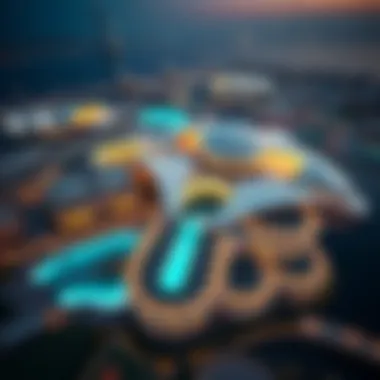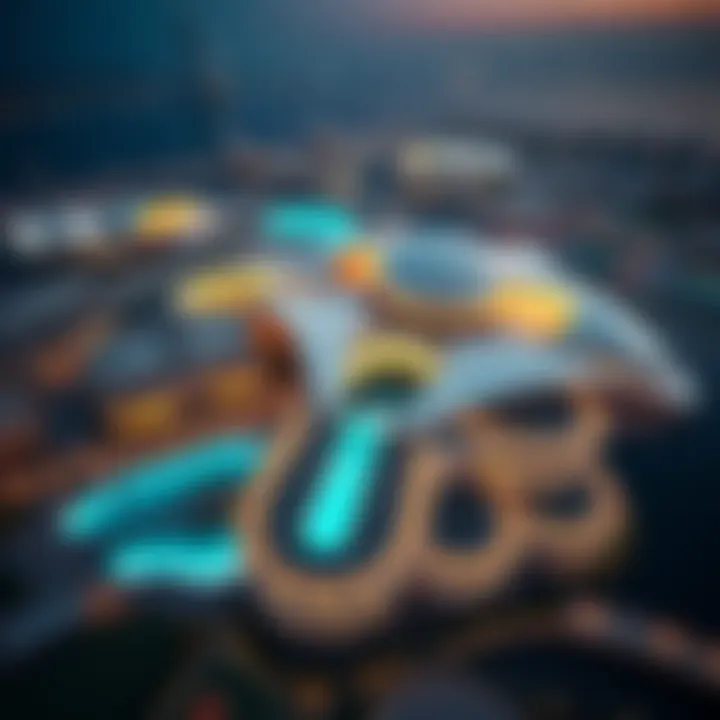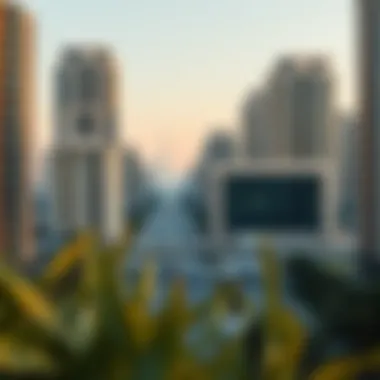Exploring Dubai's New Project: Impact and Insights


Intro
Dubai has always been a city that pushes the boundaries of modernity and ambition. Its skyline, a mosaic of innovative architecture, reflects a continuous journey of growth within the property market. As individuals and entities from various walks of life turn their eyes toward this vibrant hub for opportunities, the new real estate project promises to reshape the landscape further. Understanding the implications of this venture requires a multidimensional perspective, which we shall explore throughout this article.
The upcoming project is not simply about constructing new buildings; it encapsulates a broader vision of urban development, economic prosperity, and sustainability. Through this lens, we will scrutinize essential areas: the economic landscape, the distinctly modern design features, and the implications for both current and prospective investors. Each of these elements weaves a part of the intricate tapestry that is Dubai's real estate sector.
With the right insights, stakeholders can identify the potential benefits and challenges that lie ahead, ensuring that decisions made today lead to fruitful outcomes in the long run. Join us as we embark on this comprehensive journey into Dubai's latest real estate venture.
Market Analysis
Understanding the dynamics at play in Dubai’s real estate market provides a foundation for grasping the significance of the new project.
Recent Trends in Dubai Real Estate
The allure of Dubai’s real estate market hasn’t dimmed, despite fluctuations in global economies. Recently, there has been a surge in interest from both local and foreign investors. Notably, there is a marked increase in luxury property acquisitions, primarily driven by an influx of affluent expatriates. High-net-worth individuals are seeking not just homes, but adventures and experiences, which Dubai readily offers.
Furthermore, off-plan properties continue to capture the imagination of many investors. These properties, often at an initial discount, provide a pathway to greater ROI and flexibility in financing options. The balancing act of supply and demand remains critical, as new developments must align with actual market needs, ensuring sustainability amid rapid expansion.
Key Factors Influencing Property Prices
Several factors serve as catalysts for property prices in Dubai's ever-evolving landscape:
- Economic Diversification: The UAE's shift from oil dependency towards tourism and technology is boosting investor confidence.
- Government Initiatives: Recent reforms, including long-term visas and ownership regulations for expatriates, have made investing in Dubai easier and more accessible.
- Global Connectivity: Dubai's position as a global transportation hub creates an enviable allure for businesses and individuals alike.
"The UAE’s commitment to becoming a leading global city entails ongoing support and development in property sectors that resonate with modern lifestyles and international standards."
Investment Opportunities
Navigating investment opportunities within the new Dubai project offers myriad pathways for astute investors.
High-ROI Property Types
Investors should keep an eye on several specific property types that yield high returns:
- Luxury Apartments: Particularly those with unique design features and prime locations.
- Commercial Spaces: Amid growing tourism, retail and business spaces promise steady income streams.
- Eco-Friendly Developments: Given the global shift towards sustainability, properties incorporating green technologies are gaining traction.
Tips for First-Time Investors
Jumping into the real estate market can be daunting. Here are some straightforward tips for first-time investors:
- Do Your Homework: Spend time researching market trends, neighborhoods, and property values.
- Network: Engage with local real estate agents or join forums to gather insights and make informed choices.
- Consider Your Needs: Think about whether you want a property for rental income or long-term capital appreciation.
- Understand Financing: Familiarize yourself with the various financing options available in Dubai.
The continuous evolution of Dubai’s property market presents unique opportunities that require a well-informed approach. As the new project takes shape, both challenges and promising openings will emerge. Staying informed and adaptable will empower investors to navigate this ever-changing terrain efficiently.
For a deeper dive into the scope of this project within the broader landscape of Dubai's real estate offerings, additional resources can be found at:
Prolusion to the New Dubai Project
The New Dubai Project represents more than just a simple addition to the skyline; it is a symptom of a rapidly transforming urban environment. In an age where cities compete not only for attention but also for investment, this project emerges as a noteworthy emblem of innovation, ambition, and resilience in the face of global uncertainties.
Overview of the Project
The New Dubai Project is set to be a sprawling development that blends residential, commercial, and leisure spaces in a location that promises to become one of the hotspots of not just Dubai, but of the entire Middle East. Encompassing state-of-the-art facilities and luxuriously appointed units, the project aims to cater to a spectrum of lifestyle preferences—from young professionals to seasoned expatriates seeking refuge in the comfort of modern amenities.
The architectural design is expected to reflect a seamless marriage between contemporary aesthetics and traditional influences, capturing the essence of the UAE's rich heritage while simultaneously looking toward the future. Prospective residents will find neighborhoods designed with their needs in mind, complete with parks, retail centers, and cultural venues, all within walking distance. It's an ambitious plan, one that promises to cater not merely to the needs of today but also to the aspirations of tomorrow.
Significance of the Project in Dubai's Real Estate Landscape
The significance of the New Dubai Project cannot be understated. As the market constantly seeks dynamism and opportunities for growth, developments like this one reinvigorate the local real estate sector by attracting both domestic and foreign investors. The influx of capital stimulates economic activity, which can create jobs—not only during the construction phase but also for years to come in the burgeoning commercial and residential sectors that follow.


Moreover, this project has the potential to impact property values throughout Dubai. As it introduces new amenities and lifestyle options, existing areas may see an increase in demand, leading to higher property prices. Investors are keenly aware that early involvement can lead to substantial returns; hence, many will be watching this space closely.
The New Dubai Project serves as a testament to the emirate's commitment to progressive urban development, signaling to investors and families alike that Dubai is not merely a transient stop but a place to plant roots.
In a city where every square meter is coveted, the New Dubai Project stands as an assurance of future prosperity and sustained growth, informing both buyers and investors on the opportunities that await in this cosmopolitan hub.
Innovative Features of the Project
The New Dubai Project is not just another addition to the skyline; it’s a groundbreaking initiative set to redefine urban living. At its core, this venture embraces a myriad of innovative features that resonate with the demands of modern life while catering to the aspirations of investors and residents alike. These features elevate the project beyond mere aesthetics and functionality, weaving together technology, sustainability, and design into a tapestry that showcases Dubai's commitment to a forward-thinking urban environment.
Architectural Design and Aesthetics
When one gazes upon the architectural design of the New Dubai Project, it's impossible not to be captivated. The structures reflect a harmonious blend of traditional Islamic elements with contemporary styles, offering a unique visual narrative. Think of sweeping curves, intricate geometric details, and expansive glass facades that mirror the surrounding landscape. This seamless integration fosters not only beauty but also a sense of place.
Moreover, the design philosophy prioritizes human-scale environments—spaces that encourage interaction among residents and visitors. Incorporation of open plazas and communal areas facilitates a sense of community, making the project inviting and vibrant. Such features are significant for both buyers looking for a home and investors seeking properties with high desirability.
"Great design is not about making things look pretty; it’s about how they function and integrate into the lives of people."
Smart Technologies Utilized
With the evolution of real estate comes the need for smarter living. The New Dubai Project is equipped with smart technologies, creating an environment that prioritizes efficiency and convenience. Imagine homes embedded with IoT devices that allow residents to control lighting, heating, and security from the palm of their hand.
Moreover, smart public infrastructure improves traffic management and enhances safety. For instance, real-time monitoring systems can provide updates on public transport, while smart energy grids optimize energy consumption across the entire project. Investors would find this crucial—properties with smart features often yield higher valuations in the long run, responding to the market's shift towards tech-friendly spaces.
Sustainability Initiatives
In today’s world, sustainability isn't just an option; it’s a necessity. The New Dubai Project stands at the forefront of ecological urban development. It’s designed with sustainability initiatives that reduce its carbon footprint and foster environmental stewardship. This includes the use of renewable energy sources, such as solar panels that power common areas and green roofs that not only insulate buildings but also combat urban heat.
Efficient waste management systems and water-recycling facilities reflect a commitment to conserving natural resources. As a result, residents can live in a community where their lifestyle choices contribute to a cleaner planet. For investors, sustainability initiatives not only meet regulatory requirements but also represent a growing interest among consumers who prioritize eco-friendly living. The potential for long-term cost savings through energy efficiency is another compelling reason to consider such investments.
Economic Implications of the New Dubai Project
When looking at the New Dubai Project, understanding its economic implications is crucial for all stakeholders involved, from investors to local residents. This project represents not just a physical structure, but a catalyst for economic growth, employment opportunities, and increasing property values in the region. As Dubai continues to position itself as a global hub of innovation and commerce, this new endeavor is expected to play a pivotal role in its economic landscape.
Projected Economic Growth
The anticipated economic growth stemming from the New Dubai Project is significant. Analysts predict that the project will contribute a substantial share to the GDP over the next few years. The infrastructure improvements and new commercial spaces will draw businesses, both local and international, to set up shop in the area. By enhancing the city’s appeal, it attracts both tourists and expatriates, further boosting the diverse economic activity.
- Increased Trade and Tourism: With new retail and entertainment zones, the project is set to become a major destination. This influx is likely to result in increased trading activities, benefiting local businesses.
- Strategic Investments: Various sectors, from technology to hospitality, will receive a boost as more and more investors tap into the opportunities created by this new development.
As a net effect, the overall economic output of Dubai could see a marked increase, positioning it favorably amid global competitors.
Impact on Local Employment
A key benefit of the New Dubai Project will be its impact on local employment. It is projected that thousands of jobs will be created during both the construction phase and upon completion.
- Direct Jobs: These are primarily within construction, engineering, and design sectors, providing immediate opportunities for skilled and unskilled labor.
- Indirect Jobs: As new businesses open, additional roles in hospitality, retail, and customer services will emerge, pulling a diverse workforce from the existing local population.
- Long-term Career Development: With the growth of industries around the project, career avenues are set to expand for residents, offering multiple pathways for professional advancement.
The creation of new job opportunities will invigorate the local economy, giving residents more reasons to stay and invest in their community.
Effects on Property Values
The property market is another important aspect where the New Dubai Project is expected to leave a lasting impact. As the area develops, property values are likely to rise due to increased demand.
- Residential Units: Prospective buyers will see a surge in interest due to new housing options becoming available, correlating with heightened economic activity. This could lead to increased costs but also enhance the area's desirability.
- Commercial Real Estate: Businesses looking to establish themselves in a lively location will push demand for commercial spaces, driving up property values over time.
- Investment Potential: As property values climb, investors can expect better returns on their investments, making it a lucrative venture for those looking to capitalize on the booming real estate market.
Investment Considerations
Investment in any real estate venture isn't just about flipping a property or finding a good buy in a hot market. Particularly when it comes to a dynamic place like Dubai, investors need to navigate a landscape rich in opportunities but also peppered with risks. This section shines a light on the crucial elements that any potential investor should weigh when eyeing their stake in the new Dubai project.
Opportunities for Investors


The new Dubai project opens a treasure trove for investors, marked by results that can be lucrative if approached with an astute mindset. Here are some key opportunities associated with this venture:
- High ROI Potential: Dubai is known for its soaring property values. With the new project set to revolutionize the city’s skyline, investors can expect commendable returns as demand climbs.
- Diverse Property Options: From upscale residential units to luxury commercial spaces, the project offers variety, catering to both wealthier buyers and those entering the market for the first time.
- Strategic Location: Situated in one of the bustling hubs of the city, this project is likely to be a magnet for both businesses and residents. Proximity to transport links and essential amenities makes it even more appealing.
- Emphasis on Smart Living: Investors interested in modern living trends will find that this project incorporates smart technologies, thereby enhancing property value and tenant desirability.
Risk Factors to Assess
Every rose has its thorns, and investing, especially in a rapidly changing market like Dubai's, is no different. Here are some risks worth considering:
- Market Volatility: The real estate market can be unpredictable. Factors such as economic downturns or changes in government policy can greatly affect property values.
- Regulatory Changes: Dubai's property laws are evolving. Staying on top of legislative changes is essential. A new law could suddenly skew the profit margins or the very framework of your investment.
- Economic Conditions: The broader economic landscape can impact the project’s viability. A slowdown could lead to reduced demand, impacting the expected returns on your investment.
- Development Delays: Projects can often experience unexpected delays, which can tie up capital longer than planned.
Financing Options Available
Navigating the financial landscape for investment in this new project can feel like walking through a labyrinth. However, knowing the available options can light the way:
- Bank Financing: Many banks in Dubai offer tailored mortgage products for both local and foreign investors. It's wise to shop around to find the best rates that suit your financial picture.
- Developer Financing: Some developers provide flexible payment plans or financing options to buyers, which can alleviate the need for immediate large capital outlays.
- Investment Partnerships: Teaming up with other investors or forming a consortium can be a smart way to distribute risk while pooling resources to purchase larger stakes.
- Private Equity: Delving into private equity funds that focus on real estate can provide additional avenues, letting you benefit from expert management and diversified property portfolios.
Investing in the new Dubai project is not a decision to take lightly, but understanding these key considerations can pave the way for a more informed and potentially rewarding investment journey.
Demographic Analysis
Demographic analysis is a crucial aspect when discussing the New Dubai Project. It helps us understand who will inhabit or utilize the residential units and what these individuals expect from their living environments. With Dubai being a melting pot of cultures, the demographic profile includes a diverse range of nationalities and backgrounds. This diversity plays a significant part in dictating the types of facilities, services, and community offerings that will be essential within the project.
A thorough demographic analysis provides insights into several key elements:
- Target market identification: Who are the potential buyers or renters? Are they young professionals, families, or retirees? Each group brings unique needs and preferences to the table.
- Income levels and spending habits: Understanding the average income of potential residents helps in structuring appropriate pricing for the units and amenities, thus ensuring affordability yet maintaining quality.
- Cultural considerations: With residents hailing from various backgrounds, it’s pivotal to consider cultural needs in community arrangements, recreational offerings, and services.
This analysis also offers numerous benefits:
- Enhancing Investor Confidence: Investors who understand the demographic landscape can make informed decisions about potential returns and market sustainability. A project that meets the needs of its demographic is more likely to see steady occupancy rates.
- Guiding Development Plans: The demographic insights can direct the designs and features that developers incorporate into the project. For example, if young families are the target, community parks, schools, and child-friendly facilities may be prioritized.
- Future-proofing the Project: As population trends evolve, adapting to changing demographics can help ensure that the project remains relevant and desirable in the long run.
Ultimately, demographic analysis can be the backbone of the New Dubai Project's decision-making process. With this foundation laid, we turn to the specifics of the target audience for residential units.
Target Audience for Residential Units
The target audience for the residential units in the New Dubai Project is expected to be a blend of local residents and expatriate professionals. Young professionals drawn to Dubai for job opportunities will likely seek modern, affordable units in bustling areas, while families may look for larger accommodations that offer proximity to schools and recreational amenities.
- Young Professionals: This group typically prioritizes connectivity, affordability, and aesthetic appeal. They are looking for a vibrant lifestyle that includes nightlife, dining options, and convenient access to public transport.
- Families: Parents want to ensure their children have access to good schools and safe environments. This demographic may favor larger units with family-friendly designs, park spaces, and community-focused facilities.
- Retirees: A growing number of retirees are settling in Dubai, seeking a warm climate and vibrant lifestyle. They may look for quieter neighborhoods with medical facilities and leisure options.
By accommodating the expectations of these target demographics, the New Dubai Project can create a more tailored living experience, thereby fostering a sense of community and ensuring higher levels of satisfaction among residents.
Projected Population Growth
Dubai's population has been on a steady rise, and projections indicate this trend will continue over the coming years. Understanding this growth is vital for planning and investment decisions related to the New Dubai Project.
- Current Growth Trends: According to local statistics, Dubai’s population is expected to increase significantly over the next decade due to economic opportunities and robust urban development. Evaluating this growth gives insight into demand for housing and services.
- Implications for Housing: As the population grows, the demand for affordable and luxury housing will increase. The New Dubai Project can position itself to meet this rising demand through strategic marketing aimed at potential residents.
- Influence of Global Events: Events like Expo 2020 and revived tourism post-pandemic are projected to accelerate population growth. This means potential spikes in demand during and after these global events, and developers should be equipped to adapt.
A well-executed demographic analysis, which considers population growth alongside target audiences, will ultimately bolster the New Dubai Project’s chances of success in the competitive real estate market.
"Understanding your market is not just about data—it's about reading the heartbeats behind the figures."
For more data-driven insights, the reader may refer to Dubai Statistics Center. This resource can provide ongoing updates on demographic trends and population statistics.
Comparative Analysis with Other Projects
Comparative analysis is a crucial component in evaluating any new development, especially one as significant as the new Dubai Project. It provides insights by juxtaposing this project against similar ventures within the region and beyond. By examining the features and outcomes of past and current projects, stakeholders can glean lessons that inform expectations about potential risks and rewards. In a rapidly evolving context like Dubai’s, understanding how the new project stacks up against existing developments informs strategic decision making for investors, buyers, and developers alike.
Similar Developments in Dubai
Dubai is no stranger to ambitious real estate projects, each often more grandiose than the last. Among these, projects such as the Dubai Marina and the Burj Khalifa have set high benchmarks in luxury and architectural brilliance. The Dubai Marina, primarily focused on waterfront living, combines both residential and commercial elements, thriving on its appealing marina lifestyle. Similarly, its iconic skyscrapers redefine the skyline, showcasing modern architectural trends. Another notable project is the Dubai Creek Harbour, which aims to blend residential units with expansive green spaces, promoting sustainability amidst urban expansion.
When examined alongside these, the new Dubai Project carves out its own niche. While it also embraces luxury, it gears towards innovation and sustainability more vigorously. This nuanced differentiation positions the project to attract a diverse demographic, aiming not just at the affluent but also at eco-conscious buyers. By assessing its competition in the realm of market perception, aesthetic appeal, and community engagement, we can delineate what makes the new initiative potentially transformative.


Key Differentiators of the New Project
The new Dubai Project differentiates itself through several distinct factors. First, it integrates advanced smart technologies, enhancing living experiences and promoting efficiency. Features like smart grids, automated systems for energy management, and comprehensive security setups are becoming mainstream expectations, yet this project pushes the envelope further.
Moreover, sustainability stands at the core of the development’s ethos. This project is not merely compliant with existing sustainability guidelines but actively seeks to surpass them. By employing innovative materials and techniques, it aims to minimize its environmental footprint and create an eco-friendly urban ecosystem. For instance, the project plans to implement green roofs, rainwater harvesting systems, and an extensive array of plant species to mitigate heat and improve air quality.
Finally, the broad appeal of this project lies in its commitment to cultivating a sense of community. Unlike developments that prioritize isolated luxury, this project emphasizes shared spaces and communal areas designed to foster interaction among residents. From cafes embedded in gardens to outdoor walking paths, it aims to nurture relationships in a sprawling urban complex.
The convergence of luxury, technology, and sustainability in the new Dubai Project offers not just a place to live but a holistic lifestyle experience.
As we look deeper into these differentiators, it becomes evident that the new Dubai Project does not just occupy space but intends to reshape perceptions and experiences of urban living. This forward-thinking perspective is likely to attract discerning buyers and investors eager for sustainable and inclusive developments.
Regulatory Framework
Understanding the regulatory framework surrounding the new Dubai project is crucial for anyone looking to invest, develop, or engage with this ambitious real estate initiative. The rules and regulations not only govern the construction and operation of the project but also shape the investment landscape in Dubai. A solid grasp of these regulations helps stakeholders navigate the complexities involved in property acquisition and development.
The regulatory environment in Dubai is tailored to foster growth while ensuring adequate control over real estate developments. It encompasses a variety of policies that address safety, environmental sustainability, financing, and operational standards. Without this structured guidance, projects can falter, leading to disputes and financial losses. Thus, investors and developers must stay informed about these regulations, as they hold the key to unlocking the project's full potential.
Government Policies Impacting Development
In Dubai, government policies play a pivotal role in shaping real estate development. The government has adopted a progressive approach aimed at attracting international investors while safeguarding local interests. Among the key policies that significantly impact the new Dubai project are:
- Incentives for Foreign Investment: The Dubai government has instituted freehold areas where foreign buyers can fully own property. This opens doors for a global audience, creating a vibrant marketplace.
- Streamlined Approvals: With initiatives like the Dubai Land Department's electronic services, obtaining necessary permits is swifter and more transparent. This minimizes delays and boosts investor confidence.
- Environmental Regulations: Stringent guidelines ensure that all developments adhere to sustainable practices. This not only protects Dubai's natural resources but also enhances the marketability of the project to eco-conscious investors.
These policies are not merely regulations; they represent a commitment to creating an environment conducive to growth and innovation.
Legal Aspects for Investors
Investors need to be aware of the legal landscape that accompanies any real estate venture in Dubai. Understanding these legal aspects is fundamental, particularly when considering the new project. Here are several essential points to keep in mind:
- Title Deeds and Ownership Rights: In Dubai, all property transactions require proper registration with the Dubai Land Department. Investors are encouraged to ensure they possess clear title deeds, confirming their ownership rights without encumbrance.
- Regulatory Compliance: Buyers must understand the local laws that govern property use and modifications. These regulations often determine what can be built or modified, significantly affecting property value and usability.
- Contractual Obligations: The intricacies of contracts in Dubai real estate can be daunting. Investors should cautiously review any agreements governing their investments, as disputes can arise from vague terms or misinterpretations.
Investors who take the time to understand these legal considerations can avoid potential pitfalls, ultimately protecting their investments.
"Navigating the regulatory and legal landscape is not just about following the rules, it's about positioning yourself for success in a rapidly evolving market."
By being proactive, investors can harness the power of the new Dubai project while contributing to its success, driving the city further into the future.
Future Prospects
The concept of future prospects in relation to Dubai's new project is pivotal. It not only shapes the strategy for development but also determines how different stakeholders can benefit in the long term. As the real estate landscape in Dubai continues to evolve, understanding the projected trajectory of this initiative is essential for investors, potential buyers, and developers.
There are several elements to consider when examining future prospects. First off, the ongoing investment in infrastructure is expected to catalyze growth, allowing further developments to flourish. This could lead to an increase in property demand and a subsequent rise in values. Moreover, creating a relationship between the residential and commercial sectors will drive investor confidence and enhance community living experiences.
Some key aspects to highlight include:
- Economic growth: Predicted increases in tourism and trade as a result of this project can spill over into various sectors.
- Enhanced connectivity: The project aims to improve transport links within and outside Dubai, effectively broadening the horizon of opportunities for businesses.
- Attracting diverse demographics: A well-rounded appeal can attract international talents, thus fostering a dynamic and multicultural environment.
"The new project is not just about buildings. It's about building a community and lifestyle that people want to be part of."
Long-term Vision for the Project
The long-term vision for this project revolves around creating a sustainable urban ecosystem that is both functional and attractive. This vision goes beyond the physical structures; it's about cultivating an environment where innovation thrives and quality of life is prioritized.
By integrating cutting-edge design with sustainable practices, the project aims to set a precedent. A strong focus on green spaces, efficient water usage, and renewable energy sources will define its footprint. It’s a forward-thinking concept where growth and sustainability go hand in hand. This not only addresses immediate urban issues but also aligns with global efforts towards climate change mitigation.
To ensure the longevity of the project, stakeholders are advised to keep tabs on:
- Regulatory updates: Adapting to fast-evolving real estate laws will be crucial.
- Technological advancements: Embracing innovations can improve living conditions and attract tech-savvy residents.
Integrating New Trends in Urban Living
The incorporation of new trends in urban living into the Dubai project epitomizes a significant shift in how cities are being designed today. Urban living isn't just about having a roof over one’s head; it encompasses lifestyle choices, convenience, social interactivity, and leisure opportunities.
Some integral trends being integrated include:
- Smart Living: The integration of IoT (Internet of Things) devices facilitates smarter homes where residents can automate tasks, enhancing comfort and energy efficiency.
- Mixed-use developments: The combination of residential, commercial, and recreational spaces in one area caters to a modern lifestyle, promoting walkability and reducing transportation needs.
- Community-centric design: Fostering a sense of belonging through communal spaces such as parks, open-air markets, and gathering areas enhances social ties and attracts families and young professionals.
Overall, the future prospects of Dubai's new project are not only about immediate outcomes but about shaping how people live and interact over time. Investors looking for substantial returns would do well to pay attention to these emerging trends and align their strategies accordingly.



